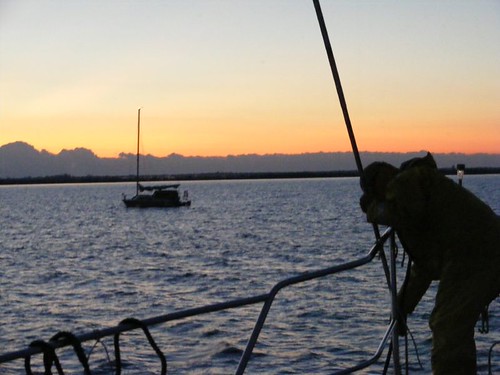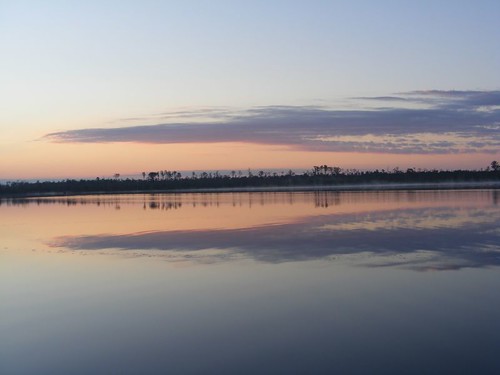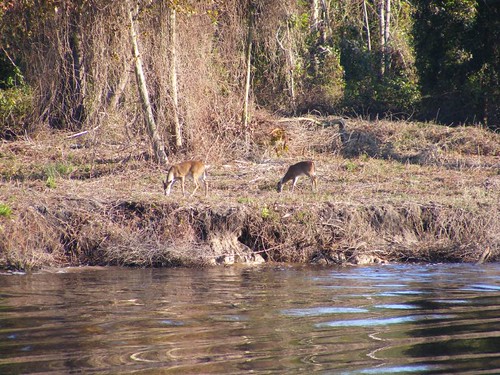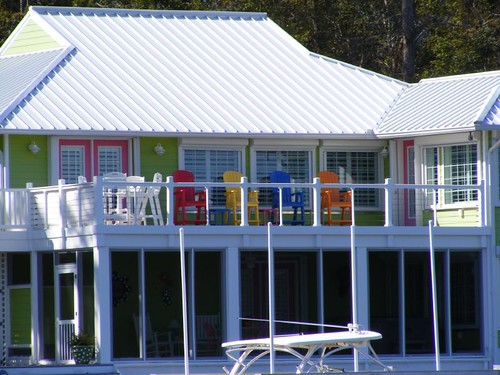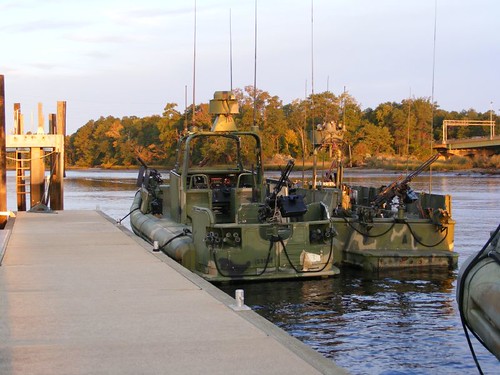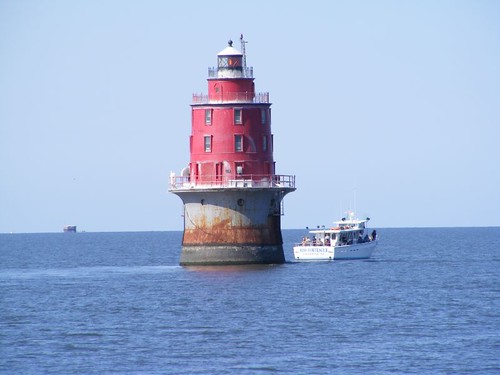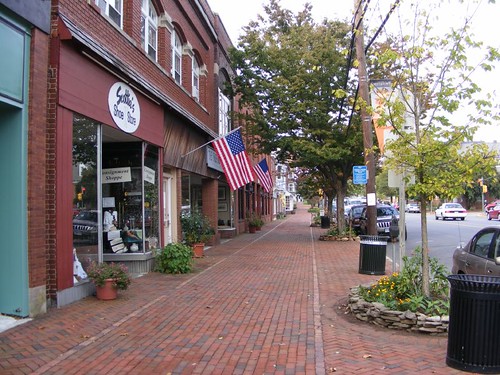September 30 – October 7
After leaving the Hudson River, we first anchored off the east side of Staten Island near Huguenot Beach, an area of single family residential homes, most of which are very large, but built right on top of one another. We had anchored here before and knew the sandy bottom provided good holding and there was plenty of room.
 Losing the back yard
Losing the back yard
We sure were surprised to see how much beach erosion had occurred since we were here in 2009, presumably from the Irene storm event since the yards looked newly eroded. There was a lot of new-looking debris: decks, railings, wall pieces, etc. Being from the east coast of Florida, it is easy to relate to beach erosion, but we had never thought about it being an issue in these parts.
After two nights of intermittent wind, rain, and thunderstorms, with a weather forecast indicating an unfavorable wind shift for our anchorage, we elected to move over to the Atlantic Highlands area. We would have better wind protection and we would be able to pump out the holding tank at the municipal marina, a task long overdue. Plus, we would finally be able to check out the anchorage in the area. Most cruising boats anchor there, but we never have because we felt it would be too crowded for us.
When we were tied up to the municipal marina's dock, trying (the suction wasn't the greatest) to pump out, a pump out boat called the HEAD MISTRESS pulled up on the opposite side of the dock. The captain handed me a brochure and told me he could have pumped us out at anchor, and his pump out worked better than the one at the dock. That service is operated free by an environmental group called the NY/NJ Baykeeper whose goal is to try to eliminate fecal matter in Raritan Bay. Many comments could be made about that.
 Atlantic Highlands
Atlantic Highlands
After pumping out, we motored a short distance away and dropped the hook on the southernmost end of the normal anchoring area where we could have plenty of room to ourselves. The area is very scenic because the high hills of the Atlantic Highlands are looming right out of the anchorage area. There is a well-used (bicyclists and walkers) waterside recreational path that looks to run along the whole area. It would have been fun to see how far it goes, but we didn't have the dinghy inflated and we only planned to stay one night. This anchorage will go on our list of acceptable places now that we have finally seen it.
By 5:40 a.m. on Oct. 3, with decent weather finally in the forecast, we were underway headed out into the Atlantic for an 11 hour cruise to Atlantic city, or so we thought.
For 6 years we have cruised in FLUKING bliss without having a serious mechanical failure. That record came to an end after we were underway about 4 hours. Eddie was at the helm, and I was standing up looking ahead when suddenly the engine starting vibrating oddly. I looked at Eddie right away, and he said “Do you feel that?” I said “Of course”, so he dropped the speed back a couple of hundred rpms, and the vibration stopped and stayed fine even after we resumed normal cruising speed. An hour later, the vibration began again, and it wouldn't go away. We had to drop down to 1000 rpms (from a normal of 1600rpms), which allowed us to only make 5 KTS.
We had to try to figure out what could be wrong. Our first thought was the vibration was due to something on the prop. I mentioned that the first time we felt it we were in an area with active commercial fishing boats, so maybe we picked up a piece of netting.
Since the ocean was too cold and rough to jump in and look at the prop, we knew we needed to get into a safe harbor. We were about 7 miles from Barnegat Light inlet, where we had gone in before to anchor, but said we wouldn't do that again because there wasn't enough room for us and the current is wicked. However, beggars can't be choosers, and that was the closest place, so that's where we headed.
We called Towboat U.S. to find out about inlet conditions to make sure we could get in under our own power and to be on standby if we ended up needing a tow. Plus, we asked TUS to arrange for a diver ASAP.
Via cell phone we arranged to get a slip at Lighthouse Marina. Eddie commented that he thought the “marina” was just for commercial fishing vessels, but we had no where else to go. When we got to the marina, Eddie was right; we were the only pleasure craft. But what the heck, we are a trawler anyway, so we were with our own kind in a way.
 Diver Don
Diver Don
Diver Don showed up in the late afternoon with enough daylight left to still be able to see all the underwater parts clearly. He gave FLUKE a clean bill of health, being impressed with how great her underwater parts actually looked. We had hoped to get off with an easy fix of just having a fouled prop that he could clean up, but no such luck. That meant something was wrong with the engine, and we probably had real trouble.
We did some of our own trouble-shooting and could determine that the vibration only happened when there was a load on the engine, which meant it was calling for more fuel, but “coughing”. We ended up calling our home mechanic to get some advice, but it was clear some diagnostic testing beyond our means was in order.
Early the next morning, Wayne called a diesel mechanic, and he was able to come out right away. We had to do a load test at the dock – really scarey! We were “bow in” the slip, so we tied off the stern and forward spring lines with our hurricane lines to hold us securely in place. Then we put the boat in forward gear and upped the engine to 1500 rpms. FLUKE was pulling on those squeaking lines with a lot of power trying to pull herself forward just like we were underway free in the ocean. I was at the helm with the throttle control just envisioning the lines giving way or the pilings getting pulled out and the bow crashing into the dock ahead of us.
The load test indicated that not enough fuel was getting into the engine, at least in one or more cylinders. So, that meant it could be some bad injectors (we have 8) or a bad injector pump. We decided to start with the easiest and least expensive option, the fuel injectors. They were removed, and the next day we found out that 3 of them were bad. We elected to replace the whole set. This news was on Wed. and the mechanic said that unless we had them sent overnight express, he couldn't get back out to us until Mon.!! We were spending $128/night to be stuck in the slip, so it was a no-brainer to spend an extra $40 to ship overnight.
The parts didn't arrive until late afternoon on Thurs., so the mechanic said that he would show up at 8:30 a.m. on Fri. If everything worked, we hoped to be able to get underway before noon and not have to pay for another night's slip. We needed to have enough time to get to the Atlantic City anchorage before dark and before all the other cruising boats got there ahead of us.
Well, rather than sit on the pity-pot fretting about the engine situation, we decided to keep ourselves busy with local sightseeing and boat chores.
The little seaside community of Barnegat Light is really very nice and would be a great vacation destination. Lucky for us, the summer season is over, so there are no crowds, no traffic, and lots of vacant wide open beach scenery to enjoy. Even when the season is in full swing, this isn't a cheesy, seaside resort. There are a few stores, artsy boutiques, small motels, and several family restaurants and bars. There are no high rises, carnival rides, or glitzy commercial signs. You would come here to fish, enjoy the expansive dunes and white beaches. There are many cute artsy beach houses for rent.
 Barnegat Lighthouse
Barnegat Lighthouse
If you arrive by boat or car, you can't miss the lighthouse at 165' high. It was first lighted in 1859. It is open daily, free, and is a great way to see the lay of the land and sea. At the intermediate levels there are information posters about lighthouses and other safety keepers of the sea.
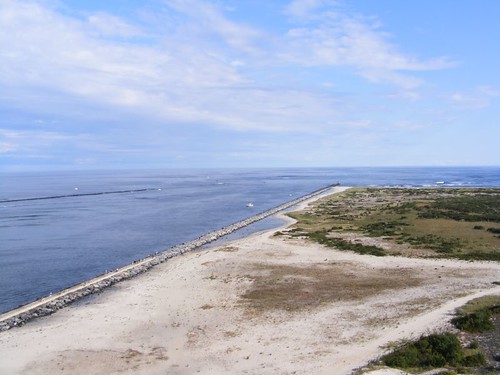 The inlet
The inlet
While the inlet in this photo may look benign, it can be very treacherous in windy conditions, and no matter what the wind or the tide are it is critical to follow the channel markers because of constant shoaling. We read that the inlet is dredged up to 3 times/year. Barnegat Inlet State Park is to the right of the inlet in the photo.
 The marina
The marina
See if you can pick out FLUKE in the photo. Most of the fishing fleet is out, so it is easier to see her. We had the opportunity to get to know several of the fishermen, and I found myself looking forward to seeing them return and hoping they had good catches of fish or scallops. It didn't feel “right” being at the marina without the fishing boats! They asked us as many questions as we asked them, and they were very sympathetic about our breakdown.
 Homeland Security
Homeland Security
The Coast Guard station is on the property right next to the marina, so we watched them take out their boats daily. When the wind was really howling, they would practice towing and docking maneuvers at their own dock, and even at our marina docks, as seen in the photo.
 Dune dreaming
Dune dreaming
The dunes cover an expansive area. Even when you arrive at the crossovers, a short distance from the street, it is a LONG walk to get to the beach, and in some places, the beach is quite wide, so it is even farther to get to the water. But the terrain is beautiful, and you can find peace and solitude. It is nice seeing a beach community where there are no houses right on the beach; all the homes are on the west side of the big dunes.
 Golden sweets
Golden sweets
Right now the dunes are ablaze with flowering goldenrod. The monarch butterflies are everywhere; we even saw them out in the ocean. These 3 butterflies had some other dinner company, the bumble bee and white moth.
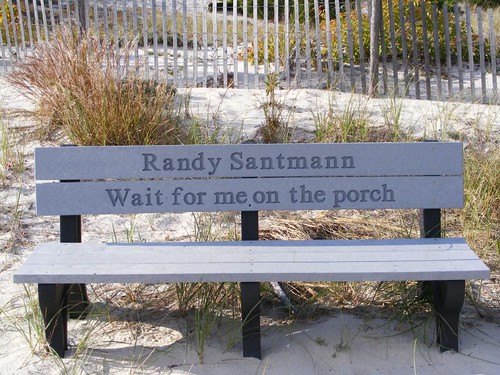 Bench memorial
Bench memorial
The community has had a successful funding program for putting up memorial benches. They are everywhere: on the crosswalks, fishing areas, along the streets, park trails, etc. Most have personalized messages in remembrance of a loved one. What a great idea.
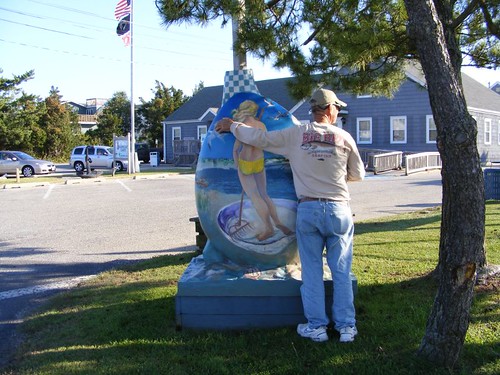 Clammy hands
Clammy hands
An environmental program has been established to try to repopulate the bay area with clams. To draw awareness to the program, artists have decorated fiberglass clams, which are on display throughout the community. Eddie was trying to get chummy with this clam digger.
When Friday morning rolled around we were in a state of anxious anticipation of the mechanic arriving and getting our engine fixed. We all had a list of jobs we needed to take care of so that we would not be delayed any more than necessary once the engine was fixed. Foolishly, I actually thought he might arrive early. Good thing I wasn't holding my breath.
The mechanic showed up at 9:30, not a word about being so late. Installation of the new injectors went along smoothly. Diver Don even showed up again wondering what had turned out to be the problem. However, when it was time to start the engine, it wouldn't fire up, presumably because air had gotten into the lines. It took a while to bleed out the air, but the engine finally turned over and was purring like a big CAT should. FLUKE still had to do that dreaded in gear test tied up in the slip to make sure all the cylinders were firing properly, and she passed.
Within half an hour, we were headed out the inlet (we have faith in that engine!), on our way to Atlantic City.
P.S. For you pop culture fans, we never did see Snookie or The Situation!










